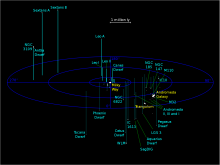Listen to today's episode of StarDate on the web the same day it airs in high-quality streaming audio without any extra ads or announcements. Choose a $8 one-month pass, or listen every day for a year for just $30.
You are here
Milky Way
If you can escape the glare of the city the next few nights, the sky will present one of its most awe-inspiring sights: the glowing band of the Milky Way. It forms a beautiful arch in the eastern sky as darkness falls, and climbs directly overhead around midnight. And the Moon is out of the way for several nights.
That hazy band is the combined light of millions of stars in the disk of the Milky Way Galaxy. The stars are too faint to see as individuals, but when you add them all up it’s an impressive sight — and one that most Americans never get a chance to see. Street lamps, billboards, store signs, and even porchlights overpower the subtle Milky Way. It’s only from a dark location — someplace like a state or national park — that you can experience the Milky Way in its full glory.
The brightest patch of the Milky Way is above the “spout” of the teapot — an outline formed by the stars of Sagittarius. It’s low in the south at nightfall. That patch of sky marks the center of the galaxy, so we’re looking into a more densely packed region of stars.
The Milky Way then climbs to Cygnus, the swan, high in the east. It’s almost fully immersed in the glow. After that, it arcs down toward the northeast. It crosses W-shaped Cassiopeia, the queen, although it’s not nearly as prominent in that part of the sky. Still, if your sky is dark enough, it’s not hard to see — the seldom-seen spectacle of the Milky Way.
Script by Damond Benningfield






